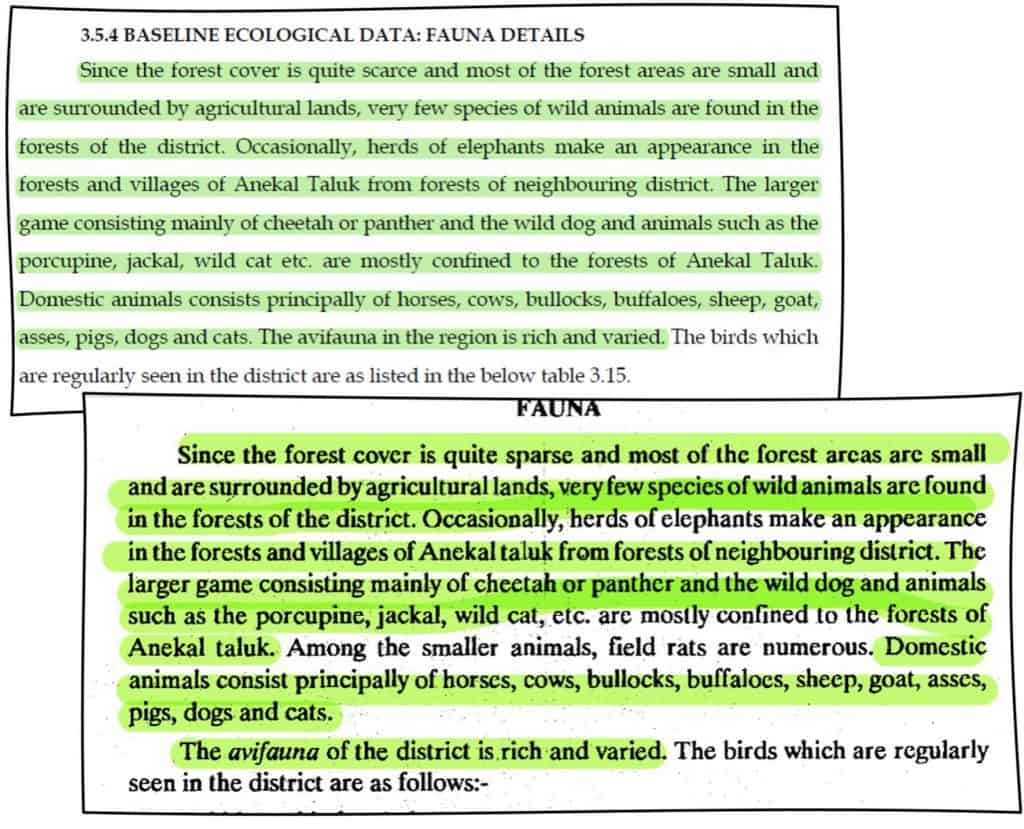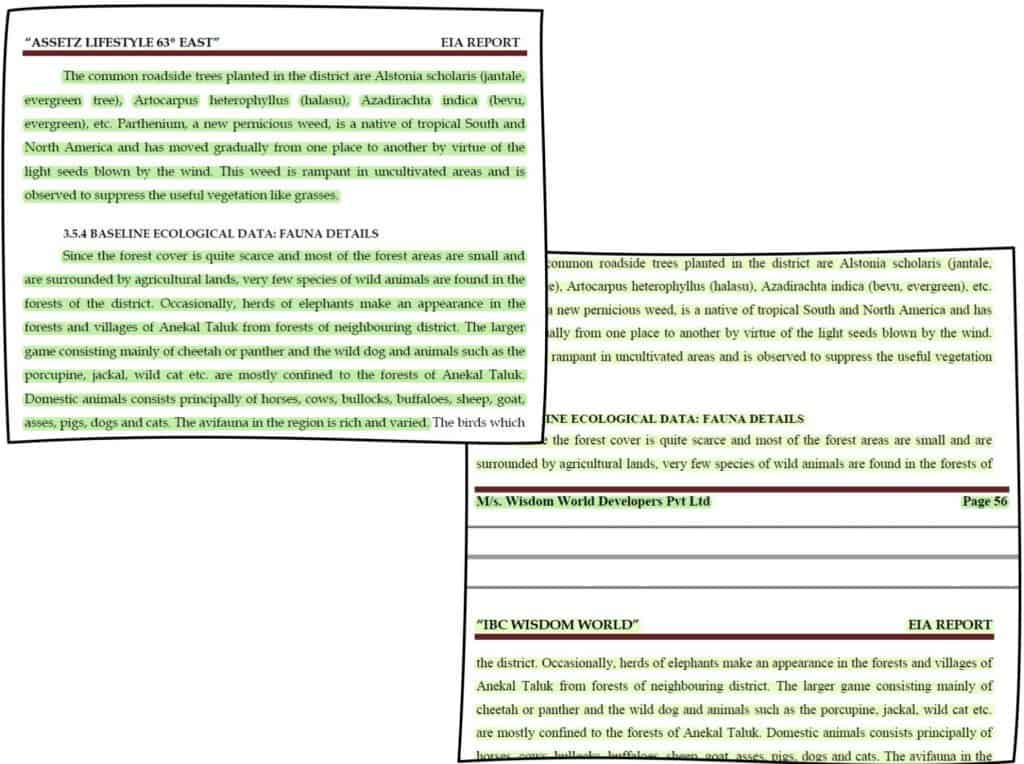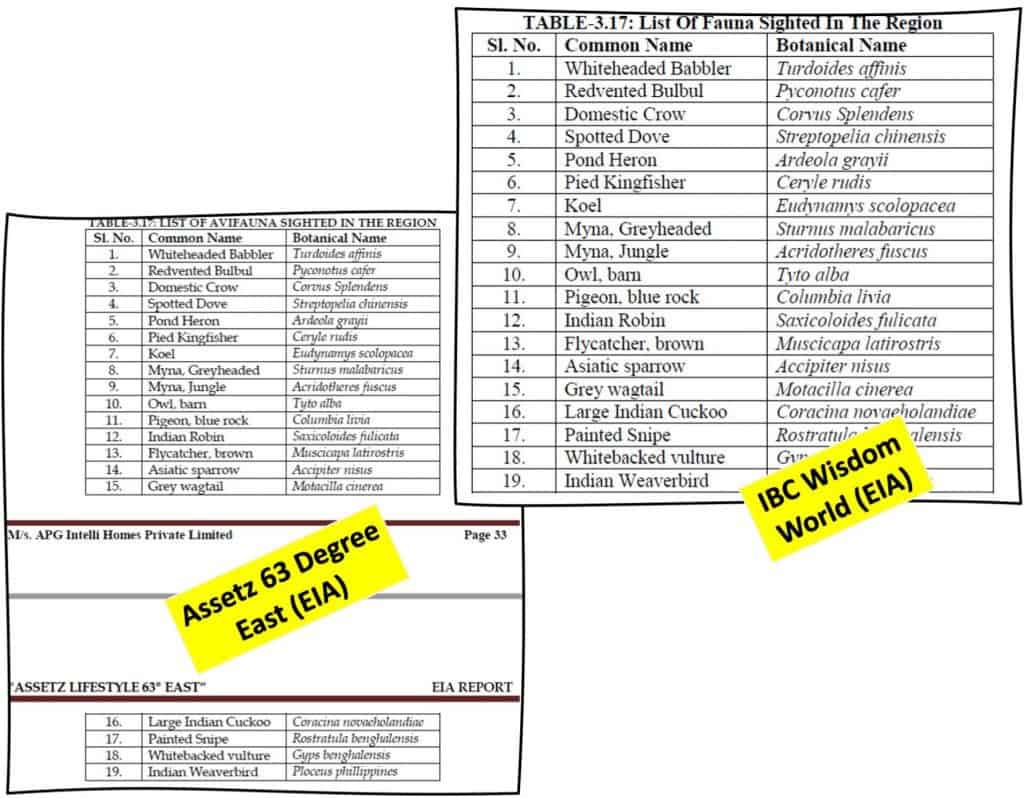Part 1 of this series looked at how mid-sized real estate projects in Bengaluru get Environment Clearance (EC) quickly, irrespective of their impact on biodiversity. But what about larger ‘township’ projects exceeding built-up area of 1.5 lakh sq m or total plot area of five lakh sq m (50 ha)? On paper, the criteria is stricter for these – the builder has to submit a detailed EIA (Environment Impact Assessment). The State Environmental Appraisal Committee (SEAC) has to assess the EIA and recommend the project, before the State Environment Impact Assessment Authority (SEIAA) clears the project.
However, environmentalists have for long questioned the quality of EIAs. Activists and researchers have pointed out the superficial nature of scientific studies as well as the lack of transparency in the scientific methods followed.
A guidance manual for EIAs does exist, but is hardly followed
In 2010, the Centre’s Ministry of Environment and Forests created a guidance manual for EIAs for construction projects. The manual says builders need to create a comprehensive inventory of “dominant, rare, endangered, threatened, endemic and indicator species” in the study area. It also states that data on densities and distribution of species, their habitat value, and historically-important specimens be included in the EIA.
But the EIAs of projects this reporter randomly selected from the SEIAA website, didn’t follow even these broad guidelines.
What is biodiversity?
Biodiversity or biological diversity is the variety of life found in any given location. This can refer to the variety of plants, mammals, insects and birds; or of habitats and ecosystems.
Why does it matter?
Research shows that biodiversity is vital to human survival and well-being.
- Protection: Biodiverse habitats within cities can offer natural protection against extreme weather events like floods and heatwaves.
- Livelihoods: Preserving a diverse set of organisms is vital to protecting livelihoods like agriculture, livestock rearing and fisheries, and providing economic security.
- Health: Access to biodiverse public parks and green spaces improves physical health by reducing exposure to pollution, and mental health by reducing anxiety and depression.
- Cultural: Biodiversity is an intrinsic part of human cultural and spiritual practices.
An example is an EIA submitted by Total Environment Constructions for the expansion of a project named ‘In That Quiet Earth’ in Bileshivale village, Hennur, in East Bengaluru. The company proposed that its residential project with a built-up area of 1.4 lakh sq m, spread over 59,642 sq m of land, be expanded to about five times its size, into a mixed development project with a built-up area of 7.8 lakh sq m spread over 2.5 lakh sq m of land.
Of the 138-page EIA report for this expansion project, only two pages were dedicated to the study of biodiversity. (Click here for the full EIA report.) From the 2.5 lakh sq m (63 acre) project site and a one-kilometre buffer zone, the report lists 11 species of trees, four mammals, five reptiles, two amphibians and 17 species of birds. Insects did not seem to merit species-level classification and were broadly grouped as butterflies, bees, ants, etc.
The reptiles listed included the Indian Chameleon and the King Cobra, two highly protected species under Schedule 2 Part 2 of the Wildlife (Protection) Act, 1972. Yet the EIA neither acknowledges this nor mentions any mitigation measures to be taken to ensure protection of such rare species.

The builder’s list also has some obvious errors. A species of rat called Rattus norvegicus is listed as a field mouse, which is a completely different type of rodent. The list of birds include bald eagles and hummingbirds, found only in the Americas.
The study also does not give any information on the abundance, densities or distribution of species, as recommended by the MoEF guidance manual. And there is no data on how construction would affect any of these birds, reptiles and mammals.
Citizen Matters wrote to Suresh Bhandari, Director of Total Environment Constructions, and to their environmental consultant Metamorphosis Project Consultants Pvt Ltd, which had prepared the EIA, on July 15th, but have not received any response.
The project, however, has not yet been approved. According to the SEIAA website, it’s currently being examined by technical experts of the SEAC. The SEIAA has not responded to our questions on the quality of this EIA’s biodiversity study.
Identical wordings in EIAs is commonplace
However, some projects that submitted even more questionable EIAs have got EC. For example, APG Intelli Homes, a private company that’s part of the Singapore-headquartered Assetz Property Group, got EC for the expansion of a residential project called Assetz 63 Degrees East in Whitefield, East Bengaluru.
In April 2017, the company sought permission to add 1.5 lakh sq m of built-up area to the project’s pre-existing 1.29 lakh sq m built-up area. SEIAA then asked the company to submit a detailed EIA.
The EIA mentions that the ecological study was conducted within a 10-kilometre radius around the project site. And that the baseline data for flora and fauna was collected over just one summer season between April and June 2017. The report says the study was a combination of primary data collected through “systematic ecological studies in the study area” and secondary sources like the Forest Department, and consultations with the local community.
But the EIA does not clearly demarcate primary and secondary data. There is no information on the nature or methodology of the systematic ecological studies done on site, or the results of these studies. (Click here for the full EIA of Asset 63 Degree East.)
Read more: Real estate developers face few hurdles in getting environment clearance
Instead, it presents a generic overview of Bengaluru, with a focus on the flora and fauna of Bannerghatta forest situated 24 km away from the project site, beyond the 10-km radius the study is supposed to have focussed on. The section on flora gives a picture of rich diversity, comprising dense scrub jungles, a variety of grasses, shrubs and herbs, and several common roadside trees.
According to the report, herds of elephants occasionally make an appearance along with wild dogs or dholes, leopards and porcupines in the forests of Anekal taluk. Special mention is made of an aquatic herb called Aponogeton natans which springs up in rock pools created by rains, on the hill tops of Bannerghatta.

If this information is confusing, it is because it has been copied from the Karnataka State Gazeteer’s chapter on environment of Bangalore District, published in 1991, neary 25 years before the Assetz 63 Degree East project was proposed to the SEIAA. The EIA report appears to provide no original biological data from the project location itself.

The report then goes on to claim that most construction activities such as site clearing, construction and road laying would have no impact on biodiversity, while buildings and landscaping would have a positive impact. How they arrived at this conclusion is not clear, considering there is no study of biodiversity in and around the project site, and no data is presented on the impacts of noise, air or water pollution on plants, birds and insects found on the site.
The report also claims that “the species identified within the terrestrial study area are not endangered, rare or protected; in addition, they will not be affected by the project”. This is despite the listing of several critically-endangered species such as elephants, leopards, dholes and white-backed vultures which are accorded the highest protection by the WPA. The project was given EC in April 2018 with no further scrutiny.

Assetz group adopted a similar process for its EIA for expansion of another residential project Assetz Marq in Bidarahalli, Whitefield. This time the text describing ‘Biological Environment’ in the EIA was lifted from the Bangalore Rural District Gazetteer, published in 1989. And the text on the project’s impact on biodiversity is identical to that in the Assetz 63 Degree East project mentioned earlier. This project has not yet been given EC. (Click here for the full EIA of Assetz Marq.)
The report of the 63 Degree East project appears to have also inspired the EIA of a commercial building project called IBC Wisdom World in Bellandur**. The latter is a project of Wisdom World Developers, a subsidiary of India Builders Corporation based in Bengaluru. (Click here for full EIA of IBC Wisdom World.)
The two EIAs are almost identical, except for the project description and details like the amount of sewage generation. The description of the biological environment, flora and fauna are identical. IBC Wisdom World received EC in July 2019.

Citizen Matters emailed and also made multiple phone calls to Assetz Property Group as well as India Builders Corporation. There was no response from Assetz. Over a phone call on July 19, Ranjana Devi from the Marketing Division of IBC acknowledged seeing our email, but is yet to respond.

The EIA reports of Assetz 63 Degree East and IBC Wisdom World have since been removed from the SEIAA website. This reporter had downloaded the EIAs of these projects from the website on May 7, and also have screenshots and saved HTMLs showing the presence of these reports on the website until this March. SEIAA Chairman K R Sreeharsha said the EIA reports were missing due to a software glitch, which was being resolved.
At the national level, identical wordings and information in EIA reports has been flagged several times over the years. As early as 2011, the environment ministry had stated that EC for such projects would be cancelled, but this doesn’t seem to have had any effect.
Conflict of interest in EIA preparation
Kanchi Kohli, an environmental researcher with the Centre for Policy Research, New Delhi, has pointed out that the process of hiring environmental consultants itself is problematic. The cost of preparing the EIA reports, conducted either by their in-house experts or external consultants, is borne by the builder. Hence there is little incentive for truly independent EIAs.
“The contracts of EIA consultants are often tied with securing ECs, so the baselines and the prediction of impacts all speak to why and how projects should be approved,” says Kanchi.
She points out that the government has tried to address this issue by introducing a mandatory accreditation process for environmental consultants. But this appears to have had little impact on the quality or integrity of the EIAs we examined.
Assetz 63 Degree East’s EIA was prepared by a consultant KRS Enterprises, while Assetz Marq and IBC Wisdom World projects’ EIAs were prepared by AM Enviro Engineers. But the EIAs were handled by the same individual K Mahadevaswamy while working at the two consulting firms at different times.
Read more: Bengaluru’s changing rainfall patterns: expert points to climate change
Over a phone call on March 8, Mahadevaswamy, who now heads AM Enviro Engineers, refused to answer Citizen Matters’ questions over phone or email. He insisted on an office meeting which this reporter could not attend due to the ongoing COVID pandemic. This reporter has not received any response to the detailed questions about the three projects, emailed to KRS Enterprises, AM Enviro Engineers and Mahadevaswamy.
SEIAA Chairman Sreeharsha said the nodal agency does not have any mechanism such as software to detect identical wording and information in EIAs. It’s up to the SEAC to identify such instances during the appraisal process. He declined to comment on the projects mentioned above, but said the SEIAA would take up this issue. The projects mentioned had been cleared during the tenure of the previous SEIAA committee.
“These practices reflect the casualness with which EIAs are prepared in India,” says Kanchi. “These EIAs and their predictions determine our ecological futures. Yet facts are held back or misreported.”
Why do builders get away with shoddy EIAs? What needs to change? We explore this in the concluding part of this series.
This article is part of a series on ‘Bengaluru’s Ecosystems and Biodiversity’. This is a joint project with Mongabay India, and is supported by the Bengaluru Sustainability Forum.
Also read:
- Heat, dust and floods: What’s up with Bengaluru?
- Bengaluru’s exotic, giant trees: Here’s where and how you can spot them
**Corrigendum: An earlier version of the article mistakenly mentioned that the 63 Degree East project EIA was inspired by IBC Wisdom World project EIA. It is actually the other way around, and the unwitting error has since been corrected.